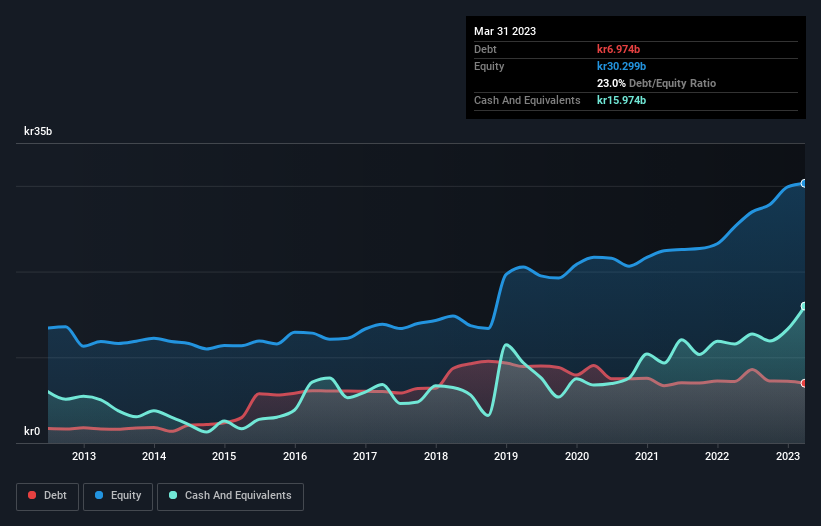- Sweden
- /
- Aerospace & Defense
- /
- OM:SAAB B
These 4 Measures Indicate That Saab (STO:SAAB B) Is Using Debt Safely

Some say volatility, rather than debt, is the best way to think about risk as an investor, but Warren Buffett famously said that 'Volatility is far from synonymous with risk.' So it seems the smart money knows that debt - which is usually involved in bankruptcies - is a very important factor, when you assess how risky a company is. We can see that Saab AB (publ) (STO:SAAB B) does use debt in its business. But the more important question is: how much risk is that debt creating?
Why Does Debt Bring Risk?
Debt and other liabilities become risky for a business when it cannot easily fulfill those obligations, either with free cash flow or by raising capital at an attractive price. Ultimately, if the company can't fulfill its legal obligations to repay debt, shareholders could walk away with nothing. However, a more usual (but still expensive) situation is where a company must dilute shareholders at a cheap share price simply to get debt under control. Having said that, the most common situation is where a company manages its debt reasonably well - and to its own advantage. When we examine debt levels, we first consider both cash and debt levels, together.
View our latest analysis for Saab
How Much Debt Does Saab Carry?
As you can see below, Saab had kr6.97b of debt, at March 2023, which is about the same as the year before. You can click the chart for greater detail. However, it does have kr16.0b in cash offsetting this, leading to net cash of kr9.00b.

How Strong Is Saab's Balance Sheet?
We can see from the most recent balance sheet that Saab had liabilities of kr32.0b falling due within a year, and liabilities of kr14.2b due beyond that. Offsetting this, it had kr16.0b in cash and kr18.0b in receivables that were due within 12 months. So its liabilities total kr12.2b more than the combination of its cash and short-term receivables.
Of course, Saab has a market capitalization of kr75.0b, so these liabilities are probably manageable. However, we do think it is worth keeping an eye on its balance sheet strength, as it may change over time. Despite its noteworthy liabilities, Saab boasts net cash, so it's fair to say it does not have a heavy debt load!
Also good is that Saab grew its EBIT at 18% over the last year, further increasing its ability to manage debt. When analysing debt levels, the balance sheet is the obvious place to start. But it is future earnings, more than anything, that will determine Saab's ability to maintain a healthy balance sheet going forward. So if you're focused on the future you can check out this free report showing analyst profit forecasts.
Finally, while the tax-man may adore accounting profits, lenders only accept cold hard cash. While Saab has net cash on its balance sheet, it's still worth taking a look at its ability to convert earnings before interest and tax (EBIT) to free cash flow, to help us understand how quickly it is building (or eroding) that cash balance. Over the last three years, Saab actually produced more free cash flow than EBIT. That sort of strong cash generation warms our hearts like a puppy in a bumblebee suit.
Summing Up
While Saab does have more liabilities than liquid assets, it also has net cash of kr9.00b. And it impressed us with free cash flow of kr5.6b, being 175% of its EBIT. So we don't think Saab's use of debt is risky. Another factor that would give us confidence in Saab would be if insiders have been buying shares: if you're conscious of that signal too, you can find out instantly by clicking this link.
If, after all that, you're more interested in a fast growing company with a rock-solid balance sheet, then check out our list of net cash growth stocks without delay.
New: Manage All Your Stock Portfolios in One Place
We've created the ultimate portfolio companion for stock investors, and it's free.
• Connect an unlimited number of Portfolios and see your total in one currency
• Be alerted to new Warning Signs or Risks via email or mobile
• Track the Fair Value of your stocks
Have feedback on this article? Concerned about the content? Get in touch with us directly. Alternatively, email editorial-team (at) simplywallst.com.
This article by Simply Wall St is general in nature. We provide commentary based on historical data and analyst forecasts only using an unbiased methodology and our articles are not intended to be financial advice. It does not constitute a recommendation to buy or sell any stock, and does not take account of your objectives, or your financial situation. We aim to bring you long-term focused analysis driven by fundamental data. Note that our analysis may not factor in the latest price-sensitive company announcements or qualitative material. Simply Wall St has no position in any stocks mentioned.
About OM:SAAB B
Saab
Provides products, services, and solutions for military defense, aviation, and civil security markets worldwide.
Flawless balance sheet with solid track record.


